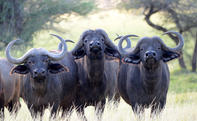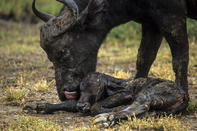Differences Between the Sexes
Buffalo are only moderately sexually dimorphic (i.e. the differences between the sexes are subtle). The older bulls are black and often caked with dried mud from wallowing.

They have massive horns with bosses that meet in the middle to form an enormous ‘helmet’ used in combat. Younger bulls have hair on their bosses. Female buffalo are more red-brown in colour and they have narrower horns and bosses.
Juveniles also have a browner colour but can be discerned from the females by their hairy coating which becomes progressively sparser with age. Both sexes have large hairy ears that hang down below the horns.
Organ-of-Jacobsen

Buffalo usually mate and calve during the rainy season when there is an abundance of highly nutritious green grass to sustain the lactating cows. Cows will give birth in the presence of the herd but may be temporarily left behind while the calf gains the strength it needs to keep up.
Although a calf may stand in just 10 minutes it takes a few weeks for it to overcome its feeble sense of coordination and clumsy running ability. Buffalo bulls test the reproductive condition of cows through flehmen whereby urine particles are pumped into the Organ-of-Jacobsen on the roof of the mouth via a muscular facial grimace to detect the presence of steroid hormones.
A cow in heat will be guarded by a bull but cows are uncooperative and their evasive activity attracts other bulls which subsequently replace the less dominant contenders. By the time the cow reaches the peak of her oestrus, the likeliest partner will by then be a dominant gene-superior bull.
By Megan Emmett